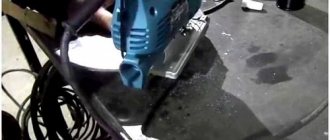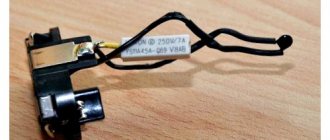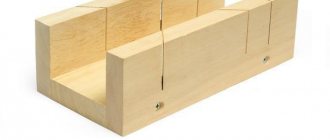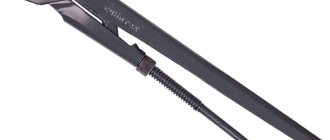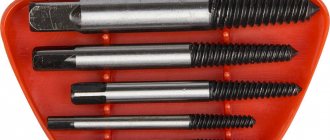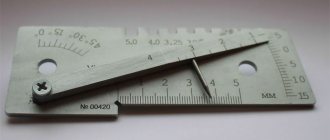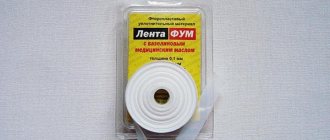Kinds
Depending on the area of application, jigsaws are divided into two main classes - household and professional. Regardless of the type, the design of the tool is equipped with a saw mounted in a special frame.
For home use, small devices for cutting materials are used. These jigsaws can be manually or electrically controlled. Each type of tool has its own technical and design characteristics.
Manual
This tool is of the simplest type. It consists of a frame, a saw blade with clamps and a handle. A manual jigsaw is used mainly for small jobs that require a certain precision of cutting.
The bottom tool allows you to perform artistic cutting of the material. But using it requires patience and skill. The sawing speed of a manual device is low, so it is not practical to use it for large volumes.
Electric
A jigsaw powered by an electrical network is considered the most convenient tool. It allows you to quickly and efficiently cut any material. The depth of the cut mainly depends on the power of the device. For modern devices, this figure can range from 200 to 900 watts.
Electric jigsaw 620 Watt
Low-power jigsaws are suitable for household use. They have a relatively low cost and do an excellent job of sawing wood products up to a depth of 50 millimeters, and metal ones - 23 millimeters. More complex work requires the use of tools with the highest technical parameters.
Jigsaw device
The following short introduction was compiled to answer the question “What is a jigsaw” and “How does it work.”
Since this is only a superficial analysis of the tool, we will not dive into the technical depths, but will only touch on the external functionality. We assure you that the information provided will fully clarify the general understanding of the concept of the device and form a clear picture of the principle of its operation. First of all, you should pay attention to the shapes of jigsaws. They can be staple-shaped or straight with a mushroom-shaped handle. The first option is the most common and very convenient, but for the sake of fairness it is worth saying that working with a mushroom-shaped handle can be quite comfortable (especially in figured cutting).
Regardless of the shape of the handle, each jigsaw has a start button and its lock (for operation without holding). Also, any device of this type has a sole, which can be stamped or cast (on more expensive models). For miter cuts, the sole can be tilted using a key or lever installed on professional devices. Saw blades, making an average of 50 strokes per second, are installed in a special clamp, which can be a block, screw or quick-clamp.
Most modern models are equipped with a pendulum function (to speed up cutting), the regulator of which is located on the left side of the body, next to the file. If we look at the structure of a jigsaw in more detail, we will notice that some models may be equipped with a backlight, a dust collector, a laser pointer and other useful devices. We described these and other functions in detail in a separate article.
For more experienced users who understand the structure of power tools, the following jigsaw diagram has been laid out. The model of a domestic manufacturer presented in analysis clearly demonstrates all the components of the “filling” of most standard devices.
Nuances of an electric jigsaw
Modern manufacturers produce various models of jigsaws. The design of any type of tool consists of the following basic elements:
- Cutting blade. All electric jigsaws are equipped with a special file, which is used to cut the material. The processing process is carried out due to the rapid reciprocating movements of the cutting element. Moreover, depending on the model, the device makes from 43 to 58 revolutions per second.
- Support sole. This design detail ensures cutting accuracy. For most manufactured electric jigsaws, the guide plane rotates at any convenient angle up to 45 degrees. Some models have a fixed slope value.
- Engine. An electric tool is necessarily equipped with a special driving system that drives the rotating mechanism. The greater the power of the device, the higher its operational capabilities.
- Holder. This element allows you to keep the tool in the correct position during the entire working process.
Some models of electric jigsaws have additional equipment. This could be a backlight or devices for automatic chip removal. Many tools have cut regulators, which make it possible to independently set the rotation speed of the cutting element for each individual type of material being processed.
Plastic cutting
A fairly fragile and at the same time elastic (depending on the purpose) material, which also has a fairly low melting point. To understand once and for all how to properly cut plastic with a jigsaw, you should know only 2 simple rules.
- It is better to keep the cutting speed below average. Of course, plastic does not have the hardness of metal to deform the teeth of a saw blade, but a high stroke rate can simply melt it.
- There are special files for working with this material, but if they are not available, you can use standard ones for wood or metal. Suitable files for cutting are T101A (where A is a small tooth), T101B (B is a larger tooth) and T101X (X is universal for wood, plastic and metal).
General rules and operating features
The quality of cutting products with both a manual and electric jigsaw depends on its correct use. Each type of tool has its own operational characteristics that should be taken into account during the work process.
Hand jigsaw
There are several points to consider when cutting material with a simple jigsaw:
- All movements of the tool must be vertical. The jigsaw should be held straight, otherwise the saw will quickly deteriorate, and the cutting process itself will be somewhat delayed. Movements are performed in only two directions - up and down.
- Do not press hard on the tool. Excessive force can significantly reduce the quality of the cut. You need to lower the jigsaw with gentle and light pressure, and when lifting it, it is recommended to be completely free.
- When cutting out a design, only the blade is rotated. The jigsaw should remain in its original position. In this case, it is necessary to hold the tool with one hand, and with the other to ensure the rotation of the material according to the intended sketch.
The manual jigsaw should not be pressed too hard.
It is recommended to place the cutting blade at the edge of the cutting line. This will ensure the accuracy of cutting curly lines.
Electrically controlled jigsaw
Using a jigsaw requires compliance with its own rules, which will help you cut the material efficiently:
- To put the tool into action, you need to connect it to the network and press the start button.
- Always press the support plate against the material while cutting. This will allow you to cut the canvas exactly along the intended line.
- The support bar must always be perpendicular to the material being processed. Incorrect placement of the guide sole can lead to damage to the product and the cutting element itself.
- When cutting the fabric into shapes, you should use a minimum of effort. Any excessive pressure on the tool can damage the workpiece.
- If it is necessary to make cuts at an angle, you must first adjust the support sole.
- When working with an electric jigsaw, you should take short breaks of ten minutes every half hour. This action will help protect the device from overheating and will greatly extend its service life.
When using an electric tool for the first time, you should set the speed to low. This will allow you to feel how the jigsaw works and get used to it.
Electric jigsaw technology
Using a jigsaw, you can cut through various materials without much effort. But still, the quality of work requires a special approach to each type of canvas.
Selection and preparation of material sheet
A jigsaw can be used to cut blades of varying densities. The material for cutting can be wood products, plastic or tiles. You can also cut metal using a power tool.
Workpieces for sawing must have a homogeneous structure. If wood panels are used, the presence of knots or metal elements such as staples, nails or screws should be excluded. Wood blanks are used for cutting only in dried form. To cut out a design, it is recommended to select a material with a flat surface.
The canvas selected for processing is fixed in a horizontal position. Cutting lines are drawn on its surface using a pencil.
Cutting down a tree
To work with wood materials, special files with fairly large teeth are installed in the tool - from 2 to 6 millimeters. The more complex the shape of the cut, the smaller their size should be.
Straight cutting of wooden panels can be carried out at the highest speeds. For more precise cutting of products, the rotation speed of the cutting element can be reduced.
To work with wood, you will need files with large teeth.
To increase the speed of material processing, it is recommended to turn on the pendulum stroke. It is used if the quality of the cut is not particularly important.
You should cut smoothly without much effort. During operation, the tool must be pressed evenly against the surface of the workpiece.
Metal processing
In this case, the cutting blade should have small teeth, the distance between which does not exceed 1-2 millimeters. During the process of sawing metal blades, the pendulum stroke is completely switched off. Material processing is performed at the lowest speed.
You need to move the jigsaw very slowly, avoiding any pressure on the tool. Before processing, the material is fixed so that the cut line is as close as possible to the support.
We cut plastic
A cutting blade for plastic workpieces is no different from a saw for metal. During the sawing process, the minimum position of the pendulum stroke is established. For smoother cuts, turn it off completely.
Plastic processing is performed at low speeds. The tool is pressed tightly against the blade and moves smoothly along its surface.
Sawing tiles
Such products require a special file with abrasive material applied in place of the teeth. In this case, the pendulum stroke is not used. The entire work process is carried out at the maximum set speed.
Cutting tiles with an electric jigsaw is used only when small cuts are necessary. This is due to the fact that saws deteriorate quickly and require frequent replacement.
Metal cutting
Not every file can cope with the strong structure of metals such as steel and even aluminum. To make your work with this material most effective, just follow simple rules.
- Set the minimum frequency of saw strokes. Unlike wood, where working at maximum speed is permissible, the dense structure of the metal will simply dull saws even with the strongest teeth. In this case, the presence of a regulator will be very useful, which will eliminate the need to buy a special electric jigsaw for metal.
- Use saw blades marked HSS (High Speed Steel). There are many types of canvases, and before purchasing, you should have a clear understanding of the thickness and density of the material you will be working with. For soft, sheet aluminum, the usual T118A is suitable, and for cutting steel, 3-6 cm thick, a T118B metal jigsaw file is suitable. Where is the first letter “T”, the name of the shank, which may not fit your instrument (more details about fasteners are written above).
Features of sawing
An electric jigsaw easily copes with straight-line sawing. Also, using the tool, you can make various cuts at an angle and cut an oval or circle in the workpiece. Each type of cut has its own characteristics.
Round and oval elements
The outline of the figure is applied to the prepared canvas. After this, using a drill, a hole is made in the workpiece into which the cutting element of the jigsaw is installed.
The cutting process begins and ends at the hole made. If you drill several holes, then a circle or oval can be cut out in parts.
Straight-line
An electric jigsaw is the easiest to handle this type of cut. Markings are made on the canvas along which the tool is smoothly guided.
For straight cutting of material, you can set the highest speed. It is recommended to secure the workpiece before starting work.
At an angle
Such cutting of the material is carried out by first installing the sole at the required degree of slope. After fixing the required angle, the same actions are performed as for straight cutting.
Sawing with a jigsaw at an angle
The nuances of straight cutting
To cut material in a straight line, a guide rail or rip fence is often used. Such additional devices greatly facilitate the work process and improve the quality of the cut.
Guide rail
This auxiliary device is a metal ruler containing a groove for installing a special sole and a jigsaw.
Before starting work, the material is marked. After that
Initially, the material is marked. After this, a tire is fixed along the line. The electric tool moves easily along the device, making precise and even cuts.
Rip fence
All models of electric jigsaws have a special hole in the support base for installing a special rip fence. The device can be purchased at a specialty store, but is often included with the tool.
The parallel fence ensures even cutting of various workpieces. But the use of such a device requires certain conditions:
- when moving the tool along the canvas, it is necessary to press the sole firmly enough;
- The surface on which the device will move must be absolutely flat.
The structure of the rip fence must be sufficiently strong and robust. Installing the device on devices that can move to the side when cutting is not recommended.
Choosing saws for a jigsaw
Saws are purchased separately and selected depending on the material of the cutting blade and what kind of cut you need: straight or figured. The packaging indicates the purpose of the saws, what material they are made of, as well as the direction and size of the teeth.
What can you cut with a jigsaw?
- wood, plywood;
- drywall;
- metal;
- aluminum;
- Styrofoam;
- glass;
- ceramics;
- rubber;
- skin;
- carpets.
This or that type of saw is selected depending on what you need to saw off.
Let's look at the types of jigsaw saws and determine what each of them can do.
There are saws:
- With a wide canvas. Designed for cutting blades in a straight line. With this type of saw, you don't need to put in a lot of effort, just adjust the direction a little. For a more accurate cutting line, you need to enable the “Soft Start” function, in which the motor gradually gains speed.
- Narrow saw. Needed for cutting material along a curved line. To cut with maximum precision, use a tool with a rotating head. The rotation radius of the head depends on the selected jigsaw model.
- With large teeth. Their purpose is to cut quickly, but the quality leaves much to be desired.
- Saws with fine teeth and a thin blade can cut out the most complex shapes.
The quality of the jigsaw depends on the method of fastening the file. When processing thick sheets with high material density, it is necessary to use equipment with rigid mounting.
Working with dull saws can lead to tool breakage due to increased load on the jigsaw motor. The quality of the cut will also decrease.
The most common breakdowns and methods for their prevention
High-quality jigsaws have a fairly long service life. But even the best models can suddenly fail. The most common tool parts that fail are:
- Start button. Basically, such a design element stops working when metal dust gets into the housing. To eliminate the problem, you need to perform simple cleaning using a special vacuum cleaner. With prolonged use of an electric jigsaw, the button fails as the mechanism wears out.
- Mechanical connections. Most often the rod gets damaged. This element is most affected by mechanical loads. The locking device, which is connected to the rod, often fails. This is all due to dust getting inside the housing while cutting various materials. But if the instrument has a high-quality body, then such problems practically do not arise.
- Engine. Stopping the electric driving mechanism can occur when the stator or rotor burns out. Also, sometimes the problem occurs due to wear on the notch on the shaft. In order for an electrical device to work long enough, its power should always be taken into account before setting certain tasks.
Improper use of the tool leads to high loads, and subsequently failure of the mechanism. When cutting for a long time, you should always periodically let the jigsaw cool down a little.
Safety precautions
A jigsaw is one of the tools that is fairly easy to use. But still, the presence of a sufficiently sharp cutting element requires compliance with certain safety rules:
- Cutting any materials should be done on a flat, stable surface with the blade first secured. In this case, cutting parts in midair is completely eliminated.
- The workpieces should be cut at a distance of at least 40 centimeters from the eyes. For protection, it is recommended to use special glasses.
- Before work, you should make sure that the file and other parts adjacent to it are firmly fixed.
- Before connecting the jigsaw to the network, you must check the integrity of the electrical cable.
- The handle of the cutting device must be securely fastened. Otherwise, the tool may slip and cause injury.
When cutting workpieces from various materials, you should always take into account the technical capabilities of the tool. Proper use of a jigsaw and compliance with all safety rules during its operation will allow you to cut any part according to the intended sketch without any problems.

